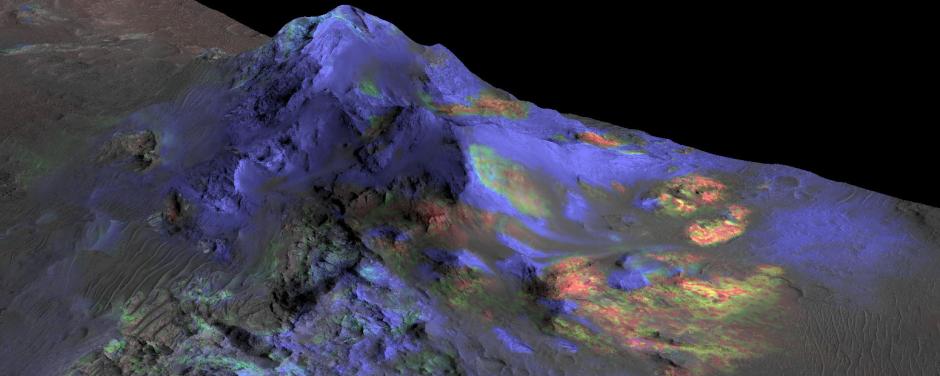PROVIDENCE, R.I. [Brown University] — Researchers from Brown University have used satellite data to detect deposits of glass within impact craters on Mars. Though formed in the searing heat of a violent impact, the glasses just might provide a delicate window into the possibility of past life on the Red Planet.
Over the last few years, several research groups have shown that, here on Earth, ancient biosignatures can be preserved in impact glass. One of those studies, led by Brown geologist Peter Schultz and published last year, found organic molecules and even plant matter entombed in glass formed by an impact that occurred millions of years ago in Argentina. Schultz suggested that similar processes might preserve signs of life on Mars, if indeed they were present at the time of an impact.
“The work done by Pete and others showed us that glasses are potentially important for preserving biosignatures. Knowing that, we wanted to go look for them on Mars and that’s what we did here,” said Kevin Cannon, a Ph.D. student at Brown and the lead author of the new research. “Before this paper no one had been able to definitively detect them on the surface.”
Cannon and co-author Jack Mustard, professor of Earth, environmental and planetary sciences at Brown, showed that large glass deposits are present in several ancient yet well-preserved craters scattered across the Martian surface. The study suggests that glass deposits are relatively common impact features on Mars and could be targets for future exploration.
The research is published online in the journal Geology.
Picking out the glassy deposits was no easy task. To identify minerals and rock types remotely, scientists measure the spectra of light reflected off the planet’s surface. But impact glass doesn’t have a particularly strong spectral signal.
“Glasses tend to be spectrally bland or weakly expressive, so signatures from the glass tend to be overwhelmed by the chunks of rock mixed in with it,” Mustard said. “But Kevin found a way to tease that signal out.”
In the lab, Cannon mixed together powders with a similar composition of Martian rocks and fired them in an oven to form glass. He then measured the spectral signal from that glass. Once he had the signal from the lab glass, he used an algorithm designed to pick out similar signals in data from the Compact Reconnaissance Imaging Spectrometer for Mars (CRISM), which flies aboard NASA’s Mars Reconnaissance Orbiter. Mustard is the deputy principal investigator for the instrument.
The technique was able to pinpoint deposits around several crater central peaks, the craggy mounds that often form in the center of a crater during a large impact. The fact that the deposits were found on central peaks is a good indicator that they have an impact origin.
Knowing that impact glass can preserve ancient signs of life — and now knowing that such deposits exist on the Martian surface today — opens a potential new strategy in the search for ancient Martian life, the researchers say.

A possible Martian site for rover exploration (white circle) is in the Nili Fossae trough. The blue-tinted Hargraves crater at the right (blue indicates a low topography) is known to contain impact glass. Image: NASA/JPL-Caltech/Arizona State University
“We think these could be interesting targets for future exploration,” Mustard said. In fact, Mustard and Cannon have a particular spot in mind.
One of the craters found to contain glass is called Hargraves, and it’s located near the Nili Fossae trough, a 400-mile-long depression that stretches across the Martian surface. The region is one of the leading landing site contenders for the Mars 2020 rover, a mission that aims to cache soil and rock samples for possible future return to Earth.
Nili Fossae trough is already of scientific interest because the crust in the region is thought to date from when Mars was a much wetter place. The region is also rife with what appear to be ancient hydrothermal fractures, warm vents that could have provided energy for life to thrive just beneath the surface.
“If you had an impact that dug in and sampled that subsurface environment, it’s possible that some of it might be preserved in a glassy component,” Mustard said. “That makes this a pretty compelling place to go look around, and possibly return a sample.”

